Godzilla: Destroy All Monsters Melee Preview
This fighting game is larger than life, and we've got new details, screenshots, and movies from the latest build.
See it in Action!
After appearing in scores of original Japanese movies and one big-budget Hollywood adaptation, with half a century of history and clear fan-favorite status, it's little surprise that Godzilla has come crashing into gaming in recent years--but in Godzilla: Destroy All Monsters Melee, he's brought his friends. In what is essentially a fighting game, you can control nearly every monster from the Godzilla universe and fight it out against other monsters in scores of classic cityscapes. The fighting itself is fun and easy to learn, but it's also deeply strategic, with unique designs, attacks, and special moves for each monster. Since the battles are truly epic, buildings will fall, cities will be leveled, and giant monsters will reign. We played a nearly complete build recently and found that even weeks before its release, the game is solidifying and features maps that are truly interactive--buildings can be used as giant projectiles, civilian enemies can attack based on which monster is hurting the city more, and strategic power-ups can become points of contention for competing monsters. The mix of solid fighting and interactive maps creates a strategic game with depth uncommon to fighting games. The game is replete with the detail and requisite mass destruction, explosions, and effects befitting the Godzilla franchise, so commanding and fighting as one of the lumbering beasts is a satisfying translation of what has made Godzilla such a long-lasting franchise.
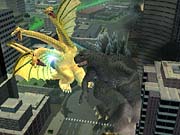
Created by Japanese film studio Toho, Godzilla was first seen in the 1954 classic Gojira and has endured in popularity since. Godzilla subsequently appeared in a total of 24 Japanese films, in which Toho introduced many monsters to accompany Godzilla. The game itself is based on the 1968 film Destroy All Monsters, which is widely believed to be one of the best Godzilla movies. The movie is particularly noteworthy for featuring nearly all of the monsters Toho created for the Godzilla universe in one outing. Blessedly, the game features nearly all of the monsters too, with 14 playable, officially licensed monsters in all. Monsters include Megalon, Gigan, King Ghidorah, Mecha King Ghidorah, Destoroyah, Rodan, Anguirus, and three Godzillas: Godzilla '90s, Godzilla 2000, and Mecha Godzilla. Mothra and Hedora also make appearances as nonplayable characters. Simply put, it's a lot of fun to maneuver and command these giant, lumbering beasts for the same reason gamers have enjoyed battling with giant robots for years--they're big, they're powerful, and they smash anything in their way. The game captures the joy of watching Godzilla and company wreak havoc, but that by itself would naturally get old without solid gameplay and smart design to capture the spirit of the movies. Thankfully, Godzilla: Destroy All Monsters Melee does just that.
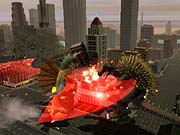
Though there's nothing revolutionary about the fighting itself, it is solid and deep with plenty of variety and options. Each monster has the customary kicks, punches, jumps with jump attacks, ducks, and blocks, plus its own primary and secondary weapons and unique abilities, like mecha monsters using ammo-based weapons. Executing basic combos is simple and requires pressing the main punch button (A) twice, followed by any other attack button, for a wide array of simple moves. Like in other games, from there it gets complicated, with the addition of different directional buttons and situation-specific attacks. To further add variety, some monsters have variations on these basic moves--for instance, Mecha Godzilla has only a single kick, and Ghidorah has three heads, adding an additional normal attack. You can also create custom combos by interrupting basic combos with other moves.
Destroy All Public Utilities
In general, each monster has a unique array of advanced moves and two special attacks. When you hold down the Z button, the primary attack is charged and then released. Charging the main attack takes energy, which replenishes over time. If you tap the trigger quickly, you fire your secondary weapon. These attacks vary for each creature but will be familiar to fans of the movies. For example, Godzilla 2000 has his atomic breath and fireball. Also, each monster has one unique attack ability, ranging from Godzilla's tail attacks and Rodan's flying attacks, to Gigan's spinning and rolling, Megalon's electrical attacks, and Destoroyah's special horn katana.
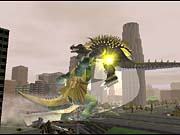
Naturally each monster also has different inherent strengths and weaknesses. For example, Godzilla 2000 is the most well rounded of the bunch and is equally strong in all three basic moves--grappling, ranged attacks, and melee combat. He is slightly faster than most and very agile, and he makes average jumps. On the other hand, Rodan is the fastest monster in the game, suited for strafing attacks and ranged attacks, but he has a weak melee attack. From what we've seen, the game is well balanced for its stage in development, which is especially surprising considering the vast array of monster abilities and options. But Godzilla is not just about the creatures themselves; it's also about the cities where the battles are waged, and the design team has wisely made the maps a huge part of the strategy.
Where Godzilla: Destroy All Monsters Melee really shines and sets itself apart from the crowd is in its environmental interactivity. Few fighting games allow you to make use of the world around you, but Godzilla one-ups the norm by making each map unique and allowing you to interact with it. No longer are you confined to arena-based fighting. There are no elevated platforms with pitfalls or hazards around them. In Godzilla, the actual city destruction plays a huge part in the gameplay. Maps include ground-based enemies, which attack the battling monsters based on which one is dealing more damage to the city. Specifically, ground troops include standard tanks, helicopters that shoot rockets, and freeze tanks that will actually hold you in place for a few seconds, making you totally vulnerable to your enemy. All of a sudden, it becomes a huge advantage to grapple enemies and fling them into buildings, because the more damage they do, the more the city hates them. It also adds an element of concern and carefulness to combat. You have to be sure you don't destroy too much of the city, or the ground troops will attack you instead. To further add to the strategic aspect, hurling buildings, trains, boulders, and other object at enemies constitutes damage to the city yet deals massive damage to enemies. It's up to you to find a good balance, and those strategic decisions are truly fun.
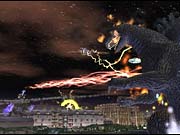
There's even more to the maps than attracting the citizens' attention, though. Power-ups appear at various places in the maps, dropped from alien ships and hidden in buildings, and collecting them can give you an advantage. Grabbing a self-explanatory health power-up can easily tip the tide of close battles. Energy replenishes power used for special attacks. The Mothra air strike power-up calls the famous Mothra to your side as an ally to attack the opposing monster. Finally, the rage power-up temporarily boosts your abilities--giving you more power to deal damage--allows a special rage attack, and is accompanied by a nifty in-engine cutscene that shows the monster entering rage.
Can I Burrow a Feeling?
Physically moving to the power-ups is a challenge in itself, since the AI is strong and will head for them too. The AI will try to block your path and get in your way, and finding a way to get to the power-ups without sacrificing tactical positioning and leaving yourself vulnerable is difficult. But remember: When you're dealing with titanic creatures, getting somewhere fast can be hard. The environment becomes a maze, and, again, finding the balance between careening through buildings and attracting local attention is tough. Different movement strategy is needed to gain an edge, and adding another layer to the gameplay, each monster has various methods of travel. Some monsters, like Gigan and Megalon, have special movements like teleporting and burrowing. Others can fly. Some must resort simply to jumping and running.
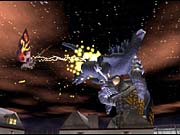
The effects and graphics have not been forgotten amid the wealth of gameplay options. After all, what would Godzilla be without the effects? Whether sonic attacks, bursts of napalm, or atomic fireballs, combat effects are suitably flashy and massive. Buildings rock as monsters smash into them, power plants explode, skyscrapers crumble when hit, and the remaining pieces, along with boats, houses, and even other monsters, can fly through the air with a simple toss. Furthermore, because of the game's solid physics model, objects fly through the air as they should, and all of the monsters rock the screen and behave as if they were truly physically massive. Details like flickering building lights, nice particle effects on the billowing smoke from the building rubble, and city automobile traffic add to the guilty pleasure of leveling cities. Similarly, the sound effects are solid too. They complement the graphics and contribute to exemplifying the game's scope and the size of the monsters. As the monsters move and attack, audible thumps accompany the shaking screen. Monster impacts are given more weight with strong bass crashes, and the necessary roars are suitably shrill and clear. Furthermore, the game supports Dolby ProLogic II for your surround sound needs. The ludicrousness of giant monsters battling each other and tearing down the world around them also, perhaps unintentionally, creates scores of hilarious moments--just as in the movies themselves--which are captured here, thanks to the details.
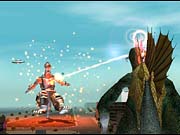
As expected, there are plenty of different game modes. The single-player adventure mode includes an extraordinarily rudimentary story that takes you from map to map fighting fellow monsters that have been released by aliens from a once-peaceful Monster Island. The adventure campaign spans eight levels, and you must play through them several times to unlock everything in the game, including hidden characters, areas, and artwork. Other modes include versus, a massive battle with up to four players fighting simultaneously; destruction, a timed city-destruction competition; and survival, a fight against monster after monster until you die. The eight main locations in the game are Osaka, Seattle, London, Los Angeles, San Francisco, Tokyo, Monster Island, and the alien mothership. Each city is split into three sector maps, for a total of 24 maps in all. Nearly every map also has the cosmetic option of being played either at night or during the day.
Set to ship in the fall, Godzilla takes lovable giant monster battles and translates them well to a progressive, contemporary fighting game. Though the story may be very basic, the developers of Godzilla seem to know what's important in fighting games, and they provide a wealth of details, locations, and options without sacrificing depth. And during our time with the game, it was clear that all the monsters seemed equally balanced as well. The addition of environmental strategy is a minor revolution in itself and is a refreshing addition to the fighting genre. The bases are covered in terms of graphics and depth, and already the game is looking refined.
Got a news tip or want to contact us directly? Email news@gamespot.com
Join the conversation